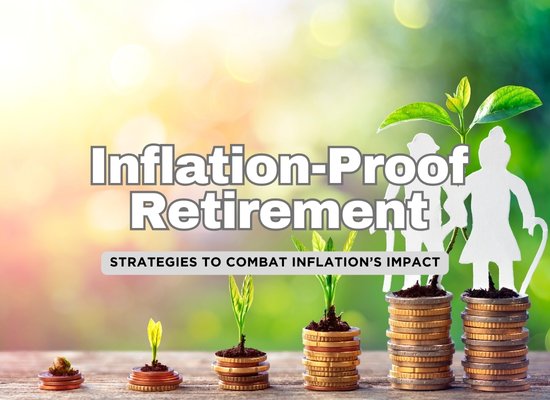Inflation can quietly erode your retirement savings over time, decreasing the value of your nest egg and increasing the cost of living. The solution? Inflation-proof investments that retain or grow their value as prices rise. In this FAQ guide, we answer 20 critical questions to help you protect your wealth and secure your retirement in an inflationary world.
1️⃣ What are inflation-proof investments, and why should retirees care?
Inflation-proof investments are assets that either maintain or increase their value during periods of inflation. These investments help prevent your purchasing power from diminishing, which is crucial for retirees who live on fixed income streams.
Why they matter:
Without inflation protection, you may need to withdraw larger amounts from your retirement savings to maintain your standard of living as prices rise. This can shorten the life of your retirement portfolio.
2️⃣ How do Treasury Inflation-Protected Securities (TIPS) protect against inflation?
TIPS are U.S. government bonds that automatically adjust their principal value based on inflation. The adjustment is tied to the Consumer Price Index (CPI), ensuring that your bond retains its purchasing power over time.
Key Benefits:
- Interest payments increase as the bond’s principal rises with inflation.
- Low risk—TIPS are backed by the U.S. government.
- Protects both your principal investment and interest earnings from inflation.
💡 BuildingRetirement Tip: Consider TIPS for the stable, inflation-adjusted returns they offer without the risk of equities or real estate.
3️⃣ Why is real estate considered a strong inflation hedge?
Real estate often appreciates in value alongside inflation, and rental income can be increased over time, which helps maintain cash flow. Properties such as multi-family units, commercial buildings, and farmland tend to perform well in inflationary environments.
Advantages:
- Property values often rise with inflation.
- You can adjust rental prices to match inflationary pressures.
- Tangible assets like real estate typically hold intrinsic value in the long term.
💡 BuildingRetirement Tip: For those who don’t want to manage physical properties, Real Estate Investment Trusts (REITs) offer a more liquid way to invest in real estate.
4️⃣ Is gold still a reliable way to protect against inflation?
Gold has long been seen as a store of value, especially during periods of high inflation and currency devaluation. Its price tends to rise when consumer confidence in fiat currencies declines, making it a popular inflation hedge.
Ways to invest in gold:
- Physical gold: Coins, bars, and bullion.
- Gold ETFs: Exchange-traded funds that track the price of gold.
- Gold mining stocks: Shares in companies that extract and produce gold.
Why it works: Gold is considered a safe-haven asset, retaining value when other markets are volatile. However, its price can be influenced by multiple factors beyond inflation.
💡 BuildingRetirement Tip: Allocate a small percentage of your portfolio to precious metals to diversify your investments and hedge against currency risk.
5️⃣ How can dividend-paying stocks help hedge against inflation?
Dividend-paying stocks, especially from companies with pricing power, can provide a steady income stream that grows over time. During inflationary periods, companies in sectors like utilities, consumer staples, and energy often pass rising costs onto customers, allowing them to maintain profitability and increase dividends.
Benefits of dividend stocks:
- Rising dividend payments help offset inflation.
- Stocks offer capital appreciation, which can outpace inflation over time.
- Helps retirees maintain cash flow without eroding their principal investment.
💡 BuildingRetirement Tip: Focus on companies with a long history of increasing dividends (Dividend Aristocrats) to ensure reliable, inflation-adjusted income.
6️⃣ Are commodities a good hedge against inflation?
Commodities such as oil, natural gas, agricultural products, and metals tend to increase in price during inflation. Since these raw materials are essential to the economy, their costs often rise with demand and inflation, making them a valuable addition to a diversified portfolio.
Ways to invest in commodities:
- Commodity ETFs: Track the price of specific commodities or a basket of them.
- Futures contracts: Allow investors to speculate on future commodity prices (higher risk).
- Commodity-producing companies: Invest in businesses that extract and sell raw materials, such as mining or energy firms.
Risks: Commodity prices can be volatile and influenced by factors such as global supply disruptions, geopolitical tensions, and currency fluctuations.
💡 BuildingRetirement Tip: Diversify by investing in commodity-focused ETFs instead of relying on single commodities to minimize risk.
7️⃣ Can investing in international stocks protect against domestic inflation?
Yes, international stocks provide exposure to foreign markets and currencies, which can act as a hedge if your home country experiences high inflation. Many emerging markets benefit from commodity exports and strong industrial growth, making them resilient to inflationary pressures.
Advantages:
- Diversifies risk by reducing dependence on domestic economic conditions.
- Provides access to higher-growth opportunities in emerging economies.
- Offers potential currency appreciation if foreign currencies outperform your own.
Challenges:
- Currency fluctuations can add volatility.
- Political and economic risks vary across regions.
💡 BuildingRetirement Tip: Invest in international equity ETFs or mutual funds to gain broad exposure without taking on the risk of picking individual foreign stocks.
8️⃣ What role does infrastructure investing play in inflation protection?
Investing in infrastructure projects—such as utilities, transportation, and energy facilities—can provide stable, long-term cash flow that is often linked to inflation. Many infrastructure assets have regulated pricing models or long-term contracts that include inflation-adjusted revenue streams.
Key benefits:
- Infrastructure investments often provide consistent dividends and capital growth.
- Inflation adjustments are built into many contracts, protecting returns from rising costs.
- Sectors like renewable energy and transportation see sustained demand regardless of economic conditions.
Ways to invest:
- Infrastructure ETFs
- Private equity funds focused on infrastructure
- Direct investments in real assets, like toll roads or energy grids
💡 BuildingRetirement Tip: Consider allocating to infrastructure funds with a track record of stable income generation during inflationary cycles.
9️⃣ How does investing in REITs (Real Estate Investment Trusts) protect against inflation?
REITs provide access to real estate investments without the need to own physical properties. Real estate typically appreciates in value during inflationary periods, and REITs often distribute rental income to investors in the form of dividends, which can increase as rental prices rise.
Benefits of REITs:
- Regular income through dividend distributions
- Exposure to commercial, residential, and industrial properties
- Easier liquidity compared to owning direct real estate
Types of REITs:
- Equity REITs: Invest in income-generating properties
- Mortgage REITs: Invest in real estate loans and mortgages
- Hybrid REITs: Combine both equity and mortgage investments
💡 BuildingRetirement Tip: Focus on equity REITs in high-demand sectors, such as healthcare facilities or data centers, for stable inflation-adjusted returns.
🔟 How do annuities with inflation riders help retirees?
Certain fixed annuities offer inflation riders that adjust your payouts based on inflation. This can provide predictable income that keeps pace with the rising cost of living.
Key features:
- Inflation riders increase your payments annually based on an index like the Consumer Price Index (CPI).
- Provides longevity protection, ensuring income for life.
- Helps maintain purchasing power throughout retirement.
Considerations:
- Inflation riders may reduce your initial payout compared to annuities without riders.
- Not all annuities offer this option, so it’s important to choose the right product.
💡 BuildingRetirement Tip: Evaluate different inflation-adjusted annuities to find one that balances payout amount and cost-of-living adjustments.
1️⃣1️⃣ Should I include inflation-indexed mutual funds in my portfolio?
Inflation-indexed mutual funds invest in assets designed to outperform inflation, such as TIPS, real estate, and commodities. These funds diversify across multiple inflation-hedging strategies and provide active management to adapt to market changes.
Why invest in them:
- They offer automatic inflation protection without needing to manage individual investments.
- Funds can provide broad exposure to inflation-proof asset classes.
- Reduces the need for constant rebalancing.
Popular fund options:
- Inflation-protected bond funds
- Real asset mutual funds (real estate, infrastructure, and commodities)
💡 BuildingRetirement Tip: Choose funds with a proven track record of performance during previous inflationary cycles to maximize returns.
1️⃣2️⃣ What role do inflation-resistant sectors, like healthcare and energy, play in retirement planning?
Certain sectors, like healthcare and energy, are less sensitive to inflation and often perform well in rising-cost environments. These industries provide essential services, allowing companies to pass costs onto consumers without losing demand.
Key sectors to consider:
- Healthcare: Hospitals, pharmaceuticals, and medical technology
- Energy: Oil, natural gas, and renewable energy companies
- Utilities: Providers of essential services such as electricity and water
Benefits:
- Consistent demand ensures stable revenue
- Companies in these sectors often increase dividends to offset inflation
- Adds diversification to retirement portfolios
💡 BuildingRetirement Tip: Invest in sector-specific ETFs or individual companies with strong pricing power to hedge against inflation.
1️⃣3️⃣ How can investing in farmland and agriculture protect against inflation?
Farmland and agricultural investments benefit from rising food prices, making them strong inflation hedges. The value of farmland typically appreciates over time, and crop yields provide recurring income.
Ways to invest in agriculture:
- Directly purchase farmland
- Invest in agriculture-focused REITs
- Buy shares in agribusiness companies
Benefits:
- Land appreciation and crop income can increase with inflation
- Agriculture is a resilient sector, driven by global food demand
- Diversifies your portfolio with real assets
💡 BuildingRetirement Tip: Look for investments in regions with stable weather conditions to reduce risks from climate-related crop failures.
1️⃣4️⃣ Can investing in renewable energy assets protect against inflation?
Yes, renewable energy projects, such as wind farms and solar plants, often have long-term contracts with inflation-adjusted pricing. These investments provide stable, inflation-proof cash flows and align with the global shift toward sustainability.
Key benefits:
- Power purchase agreements (PPAs) include inflation-linked pricing
- Renewable energy is increasingly in demand as governments push for greener solutions
- Provides regular income through energy sales
Ways to invest:
- Renewable energy REITs or infrastructure funds
- Publicly traded companies in the renewable sector
- Private equity funds specializing in renewable projects
💡 BuildingRetirement Tip: Invest in energy infrastructure funds with a mix of renewable and utility projects for diversified, inflation-adjusted returns.
1️⃣5️⃣ What is the role of inflation-linked certificates of deposit (CDs)?
Inflation-linked CDs are savings products that adjust their interest rate based on inflation. Unlike standard CDs, which offer fixed rates, these products help your savings keep pace with rising prices.
Key features:
- The interest rate is tied to an inflation index, such as the CPI
- Provides principal protection with minimal risk
- Suitable for retirees looking for low-risk, inflation-adjusted savings options
Considerations:
- Inflation-linked CDs may offer lower starting rates compared to traditional CDs
- Early withdrawals may incur penalties
💡 BuildingRetirement Tip: Compare inflation-adjusted CD rates across financial institutions to ensure your returns outpace inflation.
1️⃣6️⃣ How can peer-to-peer (P2P) lending offer inflation protection?
P2P lending platforms connect investors with borrowers, often providing higher interest rates than traditional fixed-income investments. These loans may offer returns that keep up with inflation, depending on market conditions and loan terms.
Benefits:
- Potential for higher yields compared to standard bonds or CDs
- Allows you to diversify across borrowers and loan types
- Offers a steady income stream through regular loan repayments
Risks:
- Borrower defaults can lead to partial or total loss of investment
- Returns may not always outpace inflation, depending on loan performance
💡 BuildingRetirement Tip: Focus on secured loans or those with strong credit profiles to minimize default risk while still earning competitive yields.
1️⃣7️⃣ How do inflation-protected ETFs differ from regular ETFs?
Inflation-protected ETFs focus on assets that are designed to perform well during inflation, such as TIPS, commodities, real estate, and infrastructure investments. These ETFs provide diversified exposure to inflation-resistant assets, reducing the need to manage individual investments.
Key benefits:
- Built-in inflation protection with diversified holdings
- Easier liquidity compared to direct investments in real estate or commodities
- Lower management costs compared to actively managed funds
Popular examples:
- ETFs focused on TIPS
- Commodity-tracking ETFs (e.g., gold, agriculture)
- Real asset ETFs (real estate and infrastructure)
💡 BuildingRetirement Tip: Consider a multi-asset inflation-protected ETF to spread your risk across different inflation-resistant categories.
1️⃣8️⃣ What role do private equity and alternative investments play in inflation protection?
Private equity and alternative investments often target long-term growth through real assets, infrastructure, and private companies, many of which are insulated from inflationary pressures. These investments typically include inflation-adjusted contracts and offer higher returns, though they may have lower liquidity.
Benefits:
- Higher potential returns compared to traditional investments
- Inflation-adjusted cash flows in sectors like energy, real estate, and logistics
- Provides diversification outside of publicly traded markets
Challenges:
- Investments often have long lock-in periods
- Requires high initial capital
💡 BuildingRetirement Tip: Explore private equity funds with inflation-adjusted strategies, especially those focused on infrastructure and essential services.
1️⃣9️⃣ Can high-yield corporate bonds protect against inflation?
High-yield corporate bonds offer higher interest rates than investment-grade bonds, making them more resilient to inflation. These bonds are issued by companies with lower credit ratings but often provide attractive returns to compensate for higher risk.
Why consider high-yield bonds:
- Higher yields help offset inflationary pressure
- Suitable for retirees looking for enhanced fixed-income returns
- Bonds from companies in growth sectors may perform well in inflationary periods
Risks:
- Greater risk of default compared to government or investment-grade bonds
- Bond prices may fluctuate significantly with market conditions
💡 BuildingRetirement Tip: Diversify across multiple high-yield bond funds to reduce the risk of default from any single issuer.
2️⃣0️⃣ How can you create a balanced, inflation-proof retirement portfolio?
A balanced retirement portfolio should combine various inflation-resistant assets, ensuring your wealth grows and maintains purchasing power. Key elements include real estate, equities, commodities, TIPS, and alternative investments.
Steps to build your portfolio:
- Identify inflation-sensitive sectors such as real estate and healthcare.
- Diversify across fixed-income, equity, and alternative investments.
- Incorporate TIPS and real asset funds for stability.
- Regularly rebalance your portfolio to adjust for market changes.
Benefits:
- Reduces overall portfolio volatility
- Protects both income streams and capital appreciation
- Increases your ability to handle long-term cost-of-living increases
💡 BuildingRetirement Tip: Consult with a financial advisor who specializes in inflation protection to ensure your portfolio is aligned with your retirement goals.
Inflation is an unavoidable reality that can eat away at your retirement savings if you’re not prepared. By investing in inflation-proof assets such as TIPS, real estate, dividend stocks, and commodities, you can protect your wealth and maintain your purchasing power throughout retirement.
Remember, the key is diversification—no single investment can fully hedge against inflation on its own. Building a well-rounded, inflation-proof portfolio ensures that your financial security remains intact no matter what economic conditions arise.
Are you ready to secure your retirement against inflation? Start by implementing these strategies today! 📊🏡✨



